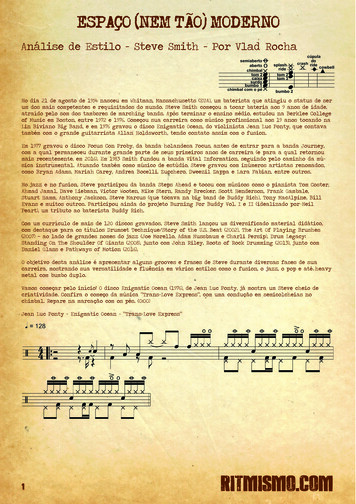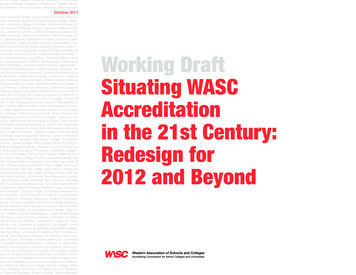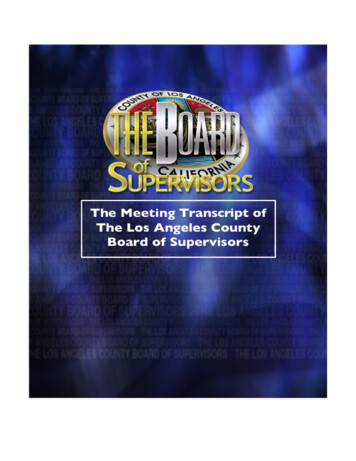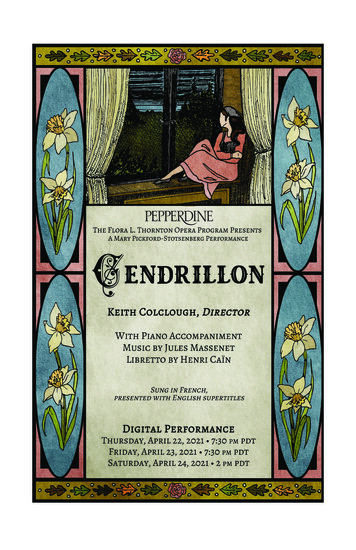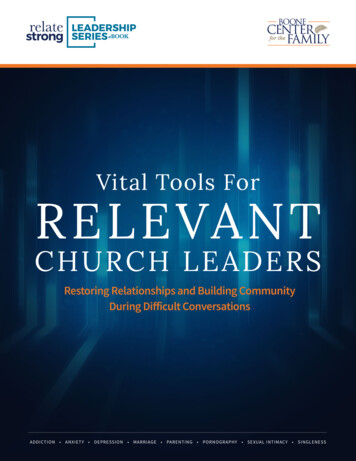
Transcription
Vital Tools ForRELEVANTCH U R CH L E A DE RSRestoring Relationships and Building CommunityDuring Difficult ConversationsADDICTION ANXIETY DEPRESSION MARRIAGE PARENTING PORNOGRAPHY SEXUAL INTIMACY SINGLENESS
A humble request beforeyou continue We hope you enjoy the eBook and feel compelledto tell others about it.Instead of forwarding this PDF to someone,please send them here to download it instead:boonecenter.pepperdine.edu/ebookWe have been able to make this eBook free to everyone thanksto generous donations. Those donations are only possible if we cantell our donors how many people we are reaching and impacting.Put simply: Every download counts.Thank you so much.
AuthorsTerry Hargrave, PhD, LMFTSharon Hargrave, LMFTKelly Haer, PhD, LMFTConnie Horton, PhD, LPScott Symington, PhD, LPMelissa Symington, PhD, LPJeff Reinke, Pastor, MEdRobin Reinke, LMFTRhett Smith, LMFT, MDivRobert Scholz, LMFT, LPCCForeword byRev. Chris Adams, PhD
Copyright 2018 by Pepperdine Boone Center for the Family. All rights reserved.No part of this publication may be reproduced or transmitted in any form or by any means,electronic or mechanical, without the written permission of the copyright holder.Unless otherwise indicated, Scripture quotations are from the ESV Bible (The Holy Bible,English Standard Version ), copyright 2001 by Crossway, a publishing ministry of Good NewsPublishers. Used by permission. All rights reserved. May not copy or download more than 500consecutive verses of the ESV Bible or more than one half of any book of the ESV Bible.Some Scripture quotations are taken from The Message. Copyright 1993, 1994, 1995, 1996,2000, 2001, 2002. Used by permission of NavPress Publishing Group.All rights reserved. No part of this book may be used or reproduced in any format withoutwritten permission except in the case of brief quotations used in critical articles or reviews.For further information, contact centerforthefamily@pepperdine.com
Table ofContents6RelateStrong: Foreword16RelateStrong: Ministry and Marriage52RelateStrong: Singleness73RelateStrong: Parenting96RelateStrong: Sexual Intimacy117 RelateStrong: Pornography138 RelateStrong: Anxiety158 RelateStrong: Depression175 RelateStrong: Addiction195 RelateStrong: Acknowledgements198 RelateStrong: Appendix
ForewordBy Christopher J. AdamsThere is no greater joy than being a pastor. Pastors are privileged toplay a very unique, symbolic, and important role in people’s lives. Noother helping profession allows the same type of access into people’slives. Pastors get to be with people in many different contexts andvery personal spaces—worship services, church board meetings, choirrehearsals, birthday parties, weddings, funerals, hospital rooms, jailcells, and courtrooms.Pastors and ministers are the generalists, the caregivers to the wholeperson, family, and community. Your relationships with individuals inyour community are special and sacred. People trust you, and theycome to you first when they are in trouble. Long before people willapproach a Christian counselor, physician, or psychiatrist, they willcome to their pastor.Clergy often express that pastoral care, counseling, and even crisisintervention are among the duties that bring them the most joy. Andyet pastoral care and counseling can also can become a heavy burden.Many pastors and church leaders are ill-equipped to address thecomplexity and severity of the issues that people bring to them, andtoo many attempt to function outside the scope of their competencies.This unintentional overreach happens for a variety of reasons. It isseductive to be viewed as the person with all of the answers. Manyministers and pastors also have codependent tendencies—a deepneed to be needed that can lead them to overfunction. Some may havegrown up in a family that was not emotionally healthy, which makes ita struggle to maintain healthy interpersonal boundaries. Most pastorsfind it challenging to always be required to draw the boundaries in themajority of their relationships.6
Christopher J. AdamsI am a third-generation pastor’s kid and a pastor myself. I grew uphearing my father and grandfather tell stories of church members—and many of those stories were not about pleasant encounters. Mygrandfather mostly served small, extremely difficult congregationsin New England. At one of his churches, one member would come bythe parsonage on a fairly regular basis just to yell at him. My fatherremembers watching this man routinely verbally rage at my grandfatheruntil he was called away to a new church in a different city. When thisman came to say goodbye, he threw his arms around my grandfatherand sobbed, saying, “Thank you, Pastor, thank you, Pastor.” Confused,my grandfather did not return the hug.This parishioner had grown up with an abusive, alcoholic father.He wasn’t really angry with his pastor—my grandfather—he was reallyangry with his own abusive father. Thankfully, my grandfather wasable to absorb this man’s emotional abuse and treat him with kindnessin return. I wonder how my grandfather processed the pain inducedby these kinds of interactions. He died young of a heart attack, and Iam convinced that his physical health issues were connected to hisministry pain.As illustrated in this story, the way people relate to you as a pastorcan easily trigger your pain and deplete your emotional resources.Research is increasingly revealing that pastors need to developemotional and relational competencies in order to flourish in ministryover time. Cultivating resilience and preventing burnout depend onhaving a well-developed sense of emotional self-regulation.COPING WITH PAINNo matter who you are or how agreeable your community is, ministryleadership will trigger your pain. Learning to be aware of your painand choosing to practice a different response in the midst of relationalcomplexities and stresses of ministry life are key to experiencing well7
RelateStrong: Forewordbeing in ministry. This book provides an introduction to concepts andpractices of Restoration Therapy, which can transform your emotionalwell-being and relationships and deepen and enhance your pastoralcare and counseling skills.The strength of Restoration Therapy, which has been developed overmany years of rigorous scholarship and clinical experience, flows fromunderstanding Pain and Peace Cycles, which are explained in depth inChapter 1. The beauty of this model is that church leaders can apply itin many different contexts—both in your own life and in the work youdo with the people you lead and serve.Terry and Sharon Hargrave developed this book and RelateStrong asa resource for pastors because of their heart for the church and theirheart for ministry leaders. Terry, a professor in the Marriage and FamilyTherapy Department at Fuller Theological Seminary, is the founder ofRestoration Therapy and author of multiple books including two onthe RT model. Sharon, Executive Director of the Boone Center of theFamily at Pepperdine University, is the founder of RelateStrong. As partof Relate Strong Leadership Series, they brought together expertsfrom a variety of fields to create this book, addressing topics that youas a pastor are likely to face in your community—and in your own life.The authors offer knowledge and insight about marriage, singleness,parenting, sexual intimacy, pornography use, anxiety, depression, andaddiction. Each chapter examines a particular topic and demonstrateshow Restoration Therapy concepts can be used in each context to helppeople move from pain to peace.INFORMED AND COMPASSIONATEPeople in your community are likely to test relationships in manydifferent ways. Emotionally unhealthy people may become aggressive,manipulative, or even seductive. Without training and boundaries,pastors may unwittingly be drawn into the pain of others. Sometimes8
Christopher J. Adamsone of the most pastoral things you can do is refuse to participatein perpetuating someone’s unhealthy relationship patterns. Modelingand teaching how Christ calls us to live differently is at the heart ofpastoral leadership.How do you recognize and respond to the pain of those in yourchurch or community? How do you lead people toward wholeness andfullness of life in Christ? How do you know your limits and recognizewhen you should refer someone to other helping professionals? Andhow do you maintain a ministry of presence and pastoral care aftersuch referrals? This book has been created to help you recognizehow pain is experienced and manifested in situations you are likely toencounter in pastoral settings and designed to equip you to respondin ways that are compassionate and informed.I encourage you to also approach this resource with your ownpersonal development in mind. Read through this book with an eye ontwo goals at once—enhancing your pastoral care and counseling skillsand growing in your own emotional and social competencies. Researchincreasingly indicates that competencies such as self-awareness,emotional self-regulation, and emotional self-control are key to helpingpastors prevent burnout, provide effective leadership, and modelChristian maturity. Pastoral ministry is an enormously complex role,particularly with regard to interpersonal dynamics. No matter who youare, pastoral leadership is likely to trigger your own pain at some point.It just comes with the territory.Dr. Archibald Hart says most pastors and ministers must wrestle withwhat he calls the 70/30 rule. Assuming that pastors are competent,psychologically healthy, and people of integrity, at least 70 percentof the criticism they receive has nothing to do with them—not athing—while about 30 percent of the criticism is valid, identifying agrowing edge or blind spot that all leaders have. Unfortunately, even9
RelateStrong: Forewordthe valid criticism is rarely given with kindness or at an appropriatetime, which blunts its effectiveness. Conversely, 70 percent of thecompliments pastors receive have nothing to do with them either—while perhaps 30 percent reflect actual strengths.What accounts for the 70 percent of unwarranted criticism andpraise? I believe much of the criticism and admiration pastors receiveis what psychologists call “transference”—people transferring thoughts,feelings, and relational patterns from a their past onto the pastor. Yourcommunity members unconsciously project onto you and relate totheir own projections as if that is who you are. The challenge for youas a pastor or church leader, then, is to stay grounded in a sense ofyour actual strengths and growth areas when most of the interpersonalfeedback you receive is not accurate. This dynamic is one of the reasonsthat pastoral ministry is lonely. Pastors do not feel that they are trulyseen or known. People relate more to your role than to who you actuallyare as a person.Frequent, often unfair, criticism can easily trigger your pain. If youare not aware of what triggers you and how you react, you are muchmore likely to react in a way that is immature, unhelpful, or evenspiritually abusive. Pastors and ministers are human, and we have ourown reactions to people—what psychologists call “countertransference.”Learning to manage these reactions is key to sustaining excellencein pastoral leadership. This book is designed to help you understandyour reactions to pain and consider what kind of people and situationstrigger you, which is the first step in developing new response patterns.Maintain accountability in your life as you learn to live out of yourPeace Cycle. Your family, friendships, and church will be transformedas a result. Learning both psychological and theological conceptsembedded in common issues your church faces will change your ownlife and relationships while also helping you develop the skills to betterhelp others.10
Christopher J. AdamsDEPRESSION, ANXIETY, AND ADDICTION“Pastoral ministry is a serotonin-depleting environment.” I onceheard a psychiatrist make this statement at a seminar, and I realizedthat psychiatrists are not unfamiliar with having clergy in their offices.Pastoral ministry can be a depression-inducing job, for a variety ofreasons. The psychiatrist I heard was highlighting the physiology ofchronic stress, which suppresses neurotransmitters in our brain. Whenour levels of these neurotransmitters, such as serotonin, are too low,we experience symptoms of depression.Pastors are also immersed in other people’s loss, including traumaticloss. Some pastors, particularly those in urban areas, experience ahigh level of trauma exposure—both direct and what experts callvicarious trauma, hearing about or witnessing other people’s trauma.The emotional impact of this exposure can accumulate over time andcontribute to depression.A number of forms of grief come with pastoral ministry, and it isoften ambiguous and disenfranchised grief. For example, when peopleleave the church there is a form of loss for pastors. The loss of ministrydreams or career opportunities can have a significant impact. Pastorsmay not be aware of the unresolved grief and loss they are carrying,and depression can be the result. Of course pastors, because theyare human, also may have personal vulnerabilities to depression andanxiety due to genetics, temperament, family of origin experiences,etc. So, it is not surprising that most pastors experience at leastmild or moderate depression symptoms at some point in their lives.Unfortunately, pastors tend to become self-critical about experiencingdepression symptoms—which of course just worsens the symptoms.Pastors can also self-medicate, like anyone, and addictive behaviorscan develop as a way of attempting to cope with pain. Pastors areparticularly vulnerable to “process addictions”—becoming addicted11
RelateStrong: Forewordto the brain’s own internal chemical processes. Workaholism, foodaddiction, technology addiction, and sexual addiction all work this wayas people become addicted to the adrenaline, dopamine, and otherchemicals that engaging in a particular behavior releases in the brain.Knowing your own Pain and Peace Cycles and having accountabilityin your life can help you avoid addictive pitfalls.This book, particularly Chapters 6, 7, and 8, will equip you withan understanding of anxiety, depression, and addiction so that youcan identify risk factors in others and yourself. If you find yourselfstruggling with any of these issues, I encourage you to respond toyourself the same way you would respond to a suffering parishioner—with grace and compassion. Seek help from a psychotherapist anda psychiatrist. Make some lifestyle changes. Understand how yourPain Cycle may be involved and develop Peace Cycle habits. Ensuresupportive accountability in your life. You are too important to toomany people to not stay healthy.SINGLES, COUPLES, PARENTSChurch life is often oriented around marriages and families, and manypeople will come to you with marital difficulty or parenting concerns.In addition, single adults—those who have never been married andthose who are single again due to divorce or death of a spouse—makeup a growing portion of our society, and our churches. For most ofChristian history, singleness was the elevated status in the church.Only in the last several hundred years has marriage been elevated to aplace of prominence. Chapter 2 of this book provides powerful insightsabout the needs of single adults—a sometimes overlooked area ofpastoral care.Pastors have a key role in helping people think through a theologyof marriage, which I believe is based on a theology of singleness. Oneof my favorite pastors likes to ask couples in premarital counseling,12
Christopher J. Adams“How will the two of you getting married to one another at this pointin time enhance the kingdom of God?” I like this question because itplaces marriage in the context of a larger story—the story of God. Itplaces marriage in the context of Christian discipleship, which is one ofthe reasons pastors uniquely grieve when marriages end. Pastors andchurch leaders can also be powerful agents of insight and healing whenequipped well. Theologian Martin Luther wrote about three imagesfor marriage: a school, a hospital, and a mission station. He wrote thatmarriage is a school of character. When Christian marriage is at itsbest, it is a means of grace—a way through which God makes us moreChristlike. Luther suggested that marriage is also a hospital—a placewhere we can receive healing from childhood emotional wounds thatcause us pain. Christian marriage is inherently therapeutic. Luther alsodescribed marriage as a mission station—the place from which childrenare sent into the world to participate with God’s redemptive work.Pastoral ministry places unique benefits and demands on clergyfamilies. Many pastors’ families describe a deep joy in sharing ministrytogether and having a wonderful support system in the congregationwhile also describing the experience of living life “in a glass house”or a “fish bowl.” They are aware of being scrutinized, as people haveunrealistically high expectations for a pastor to have the perfectmarriage and children. Pastors’ spouses and kids can be expectedto fill their role in uncomfortably stereotypical ways and oftenexperience profound loneliness.I am convinced that in some ways it is even more difficult to bethe spouse of a pastor than to be the pastor. Pastors’ spouses canfeel a profound sense of helplessness to intervene in the relationalcomplexities of church dynamics and may face high expectations thatthey will serve as an “unpaid associate pastor,” but with very littlestatus or compensation. And too often, pastors demonstrate what onecounselor calls the “St. Elsewhere syndrome”: a saint everywhere else13
RelateStrong: Forewordwho comes home too emotionally depleted to be fully presentwith spouse or kids.Chapter 1 of this book is designed to give you insights intomarriage so that you can help provide marital enrichment andmarital crisis intervention to your community. It can also helpenrich your own marriage and family, while Chapter 3 can giveyou new insights on parenting that can be helpful in your churchand also in your own family.SEXUALITYWe live in a sexually confused culture. You are likely to encountersexual brokenness in people’s lives in ways that are surprising andintense. Pastors are often the first person to hear someone’s storyof sexual abuse, and they often hear confessions of compulsive oraddictive sexual behavior, such as pornography, affairs, and moreunusual behavior. The shame that is typically connected to sexualitycan become entangled in Pain Cycles in complex kinds of ways.Chapter 4 will help you recognize the role of sexual intimacy in ahealthy marriage, while Chapter 5 addresses the growing dangers ofpornography use in our culture. Both will help you as a pastor to guidepeople into finding healing from shame and serve as a bridge to morespecialized forms of care and treatment when needed.I sometimes wonder if parishioners and pastors alike believe thatpastors are supposed to be “asexual” somehow. Pastors are oftenambivalent about their sexuality or try to repress it to an excessivedegree. And yet pornography use is an epidemic among clergy, andthe rate of sexual misconduct among clergy is alarmingly high whencompared to other helping professions such as doctors, lawyers, andtherapists. Many pastors have not psychologically integrated theirown sexuality in a healthy way and so find themselves caught offguard by their own desires and behaviors. They may find themselves14
Christopher J. Adamsexperiencing loneliness and criticism and realize too late that theyhave neglected their marriage due to the demands of ministry.Intimacy can develop in a pastoral relationship that crossesboundaries inappropriately, violating trust. Pastors are too often notprepared for parishioners to have sexualized transference—to beattracted to them, offer themselves sexually, or even actively seducetheir pastor as the “forbidden fruit.” In addition, pastors can engagein sexual behavior as a way of self-medicating their own pain. Thesekinds of scenarios are all too common and very destructive on anumber of levels.This book includes information and resources to help you understandthe deeper dynamics of human sexuality so that you can provide betterpastoral care for those who are struggling. It can also provide benefitsfor you personally if you find yourself struggling with these issues. Iinvite you to engage in honest self-assessment. You are human. Youhave a sexuality. Are you moving toward wholeness in this area ofyour life?A DUAL RESOURCEI am thankful to be a part of the team of professionals who haveworked together to create this resource for leaders in the church. Iencourage you to access the material in this book along both pathways,professionally and personally. May the God of peace bless you as youcare for God’s people.CHRISTOPHER J. ADAMSRev. Christopher J. Adams, PhD, is the Executive Director of the Center for VocationalMinistry at Azusa Pacific University.15
ONE—RelateStrong:Ministry and MarriageBy Terry HargraveIf you have logged any time in ministry or leadership with faith-basedorganizations or churches, you know the country is facing seriousproblems with relationships and families. These problems have beengrowing in our culture for quite some time, and it has become quiteeasy to numb ourselves to the sheer reality of the statistics indicatingthe depth of our problems.Fewer people are marrying worldwide; we now see only about 2.3million marriages each year in the U.S.—down from over 4 millionin the 1990s. Although there is some reason to believe the divorcerate is stabilizing, the reality is that about 42 percent to 45 percentof marriages will end in divorce. Add in the number of couples whopermanently separate without divorcing, the failed marriage ratestill approaches the 50 percent mark in the U.S. Divorce rates aremuch lower among college-educated and socioeconomicallyadvantaged families, but if your community does not fall into thosedemographic categories, you probably continue to witness high ratesof family break-ups.On top of that, about 56 percent of people cohabitate beforemarriage. In fact, cohabitation rates are about 7.3 million per year—16
Terry Hargravealmost double the marriage rate. Only half of these cohabiting coupleswill eventually marry, even though 40 percent of them will havechildren together while not married. More people than ever are alsochoosing to stay single, and current estimates predict one in fouradults will have never married by the time they turn 50. Those whodo eventually marry are staying single longer, trusting their maritalpartners less, and depending on themselves more.The numbers leave little doubt: Marriage and family are in an age ofdecline. The late Pope John Paul II warned, “As the family goes, so goesthe nation and so goes the whole world in which we live.” Few wouldargue this point, but we can also safely say, “As marriage and the familygo, so goes the church.”The numbers are disturbing enough, but you likely know the painof a seemingly happy couple coming in to see you—a couple who hasbeen dedicated to serving in the church, helping others, and perhapseven supporting your ministry—and announcing they are devastatedby an affair, trapped in a cycle of domestic violence, languishing inan unhappy relationship, or giving up and divorcing. Numbers can beignored; culture can be ignored; but the couple in front of you cannotbe ignored. As a leader in your church or organization, you are keenlyaware that every ministry and every person and every relationship inyour community will be weakened by the loss and pain of the couple infront of you.What will you do in that moment? In fact, what will you do with allthe overwhelming relationship problems that come to you in the formsof parenting issues, unrealized family expectations, sexual problems,addictions, anxiety, or depression? And if shepherding your peoplethrough these tremendous difficulties is not difficult enough, what willyou do when you and your own family are dealing with such issues?Invite someone you know to download this book free at boonecenter.pepperdine.edu/ebook17
RelateStrong: Ministry and MarriageRelateStrong Leaders was created specifically to give pastors,ministers, and other church leaders tools to help you strengthenmarriages, families, and other relationships in your communities. Whileyou cannot do everything, we know that leaders, pastors and ministerspowerfully shape yourselves and the people you minister to. In fact, webelieve you have more power than you think! We want to help you helpyour people by equipping you with a simple model called RestorationTherapy (RT), a tool you can use consistently to address some of thedifficult problems you face in your faith community. With it you canhelp strengthen marriages, teach new skills to parents, help singleadults understand their value, and support people struggling withaddiction, sexual problems, pornography, depression, anxiety,and other issues.WE KNOW YOU ARE NOT A THERAPISTWe are not asking you to be a therapist. Restoration Therapy is simplythe title of a model that can help you provide pastoral care that not onlywill help your people psychologically, but also spiritually. We are simplyasking you to be yourself—a powerful person who is able to listen tothe stories and narratives of the people you serve and direct themby your pastoral knowledge to a deeper level of sound relationshipsand spiritual growth. Of course, you will still utilize the resources oftherapists, psychologists, doctors, and other experts, but you will alsobe empowered to better support your community from the pulpit, inone-on-one settings, through small-group interactions, or in wholechurch programming. RelateStrong and the restoration model are notabout you becoming a therapist but about you learning a language thathelps you assess and understand the community of people you serve.And perhaps most important, you will learn about yourself and yourown relationships.Read more about this topic on our blog at boonecenter.pepperdine.edu/blog18
Terry HargraveRelateStrong and this model teach that humans—all humans—are built to be relational with one another. In other words, we canonly develop fully and optimally within the context of relationship.Relationships are built on two foundational pillars that we absolutelyrequire to function properly: love and trust.Importance of LoveChances are you know a thing or two about love already. There areso many great things about love, but one of the most essential keys tounderstanding humans is to understand that everything we know aboutourselves was taught to us by the way we were—and are—loved. Simplystated, one of the essential ways we understand ourselves is to discernwhether we matter to the people who are in relationship with us. Weface tragic and long-lasting consequences if we do not experience thislove from the very beginning of our lives. If caregivers do not love andattach to an infant, the child will fail to develop in a normal manner; inworst-case scenarios, without the basic bonding that lets babies knowthey are important and belong, they will fail to thrive and may even die.Touching, cuddling, and comforting stimulate the brain in infancy andare essential to love, attachment, and eventual identity.But of course, the story of love in shaping a person’s identity extendspast infancy and throughout a person’s life. We like to think that loveis expressed in three fundamental ways: romantic love, companionatelove, and sacrificial love. You will notice that these three typescorrespond closely to the Greek terms for love: eros, phileo, and agape.We most often think of eros love as an erotic love fitting for romanticrelationships. But actually, it is more closely aligned with the feelingswe get when we are fascinated and consumed by thoughts of abeloved—almost to the point of being unable to imagine life withouthim or her. For instance, I could use the concept of romantic love toInvite someone you know to download this book free at boonecenter.pepperdine.edu/ebook19
RelateStrong: Ministry and Marriagedescribe my feelings toward my young grandson. And when I holdmy grandson and sing to him, tell him how special he is, and focusexclusively on him, he begins to think, “I must really be something,and I can get this person to do anything for me.” In other words, myromantic infatuation with my grandson makes him feel special, unique,and important.Of course, parents and family members love their children in thisinfatuated, all-encompassing way, even if we don’t always describe itas “romantic” love. And God also expresses this kind of love toward us.“Those who were not my people I will call ‘my people,’ and her who wasnot beloved I will call ‘beloved’” (Rom. 9:25; see Hosea 2:23). The lovingthoughts and actions of our family members and God communicate toour identities that we are special and prized.Identity is also greatly influenced by companionate or phileo love.Think about your best friend for a few moments. Chances are, youwill have stories that come to mind that illustrate how your friend isfaithful, loyal, fun, and spontaneous. Even if you do not live close toyour friend or talk to him or her often, you likely still feel that he or she“gets you” and would be there in an instant if you asked. Best friends“have our backs.”This kind of companionate or friendship love teaches our identitiesthat we are not alone and that we truly belong in the context ofrelationship. You see this kind of love expressed beautifully in therelationship between Ruth and Naomi. Ruth says, “Do not urge me toleave you or to return from following you. For where you go I will go,and where you lodge I will lodge. Your people shall be my people, andyour God my God. Where you die I will die, and there will I be buried”(Ru
May not copy or download more than 500 consecutive verses of the ESV Bible or more than one half of any book of the ESV Bible




